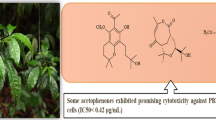Abstract
A new aporphine alkaloid, β-magnoflorine (1), together with a known aporphine alkaloid, α-magnoflorine (2), were isolated from the aerial parts of Clematis parviloba. Their structures were elucidated on the basis of comprehensive spectroscopic techniques. In addition, both compounds showed potent antifungal activities against Penicillium avellaneum UC-4376.
Similar content being viewed by others
References
BarbosaFilho, J. M., DaCunha, E. V. L., Cornélio, M. L., Dias, C. D. S., and Gray, A. I., Cissaglaberrimine, an aporphine alkaloid from Cissampelos glaberrima. Phytochemistry, 44,959 (1997).
Cheng, P., Ma, Y. B., Yao, S. Y., Zhang, Q., Wang, E. J., Yan, M. H., Zhang, X. M., Zhang, F. X., and Chen, J. J., Two new alkaloids and active anti-hepatitis B virus constituents from Hypserpa nitida. Bioorganic & Medicinal Chemistry Letters, 17, 5316 (2007).
Dwuma-Badu, D., Ayim, J. S. K., Withers, S. F., Agyemang, N. O., and Ateya, A. M., Constituents of west African medicinal plants. XXVII. Alkaloids of Rhigiocarya racemifera and Stephania dinklagei. Journal of Natural Products, 43,123 (1980).
Espinel-lngroff, A., White, T., and Pfaller, M. A., Antifungal agents and susceptibility tests. Manual of Clinical Microbiology, 7th Edn. (Murray PR ed.), American Society for Microbiology, Washington DC, 1640 (1999).
Kûpeli, E., Kosar, M., Yesilada, E., Baser, K. H. C., and Baser, C., A comparative study on the anti-inflammatory, antinociceptive and antipyretic effects of isoquinoline alkaloids from the roots of Turkish Berberis species. Life Sciences, 72, 645 (2002).
Marsaioli, A. J., Reis, F. A. M., Magálhaes, A. F., and Rúveda, E. A., 13C NMR analysis of aporphine alkaloids. Phytochemistry, 18, 165 (1979).
Racková, L., Májeková, M., Košt’álová, D., and Štefek, M., Antiradical and antioxidant activities of alkaloids isolated from Mahonia aquifolium. Structural aspects. Bioorganic & Medicinal Chemistry, 12, 4709 (2004).
Slavík, J., Bochoráková, J., and Slavíková, L., Collection of Czechoslovak Chemical Communication, 52, 804.
Tringali, C., Spatafora, C., Cali, V., and Simmonds, M. S. J., Antifeedant constituents from Fagara macrophylla. Fitoterapia, 72, 538 (2001).
Author information
Authors and Affiliations
Corresponding author
Rights and permissions
About this article
Cite this article
Chen, JH., Du, ZZ., Shen, YM. et al. Aporphine alkaloids from Clematis parviloba and their antifungal activity. Arch. Pharm. Res. 32, 3–5 (2009). https://doi.org/10.1007/s12272-009-1111-7
Received:
Revised:
Accepted:
Published:
Issue Date:
DOI: https://doi.org/10.1007/s12272-009-1111-7




